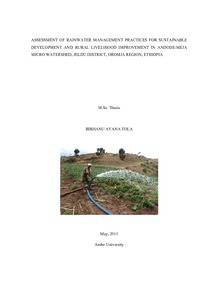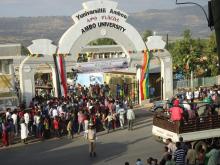Resource information
Poor rainwater management (RWM) and a resultant problems of land degradation, low agricultural
productivity, food insecurity and poverty, are particularly severe in the rural highlands of Ethiopia. This study was undertaken at Andode/Meja micro watershed, which is located in the Jeldu district of west shoa zone in the Oromia region. The study was aimed to assess major problems and potentials for sustainable rainwater management for the improvement of rural livelihoods in the study area. Socioeconomic conditions, biophysical and their management practices were assessed in the watershed under study. Using GPS and GIS techniques, the existing RWM interventions, the extent, and the nature of changes in LULC were also assessed and mapped for reflecting both the biophysical conditions and their management status in the study watershed. Furthermore, soil laboratory analysis was done for soil samples collected from the upper 0 - 20 cm depth from land utilized for crop cultivation, grazing and natural forest/ eucalyptus plantation in order to compare the relative soil degradation with some selected physico-chemical properties of soil. The results of the study indicated that, with few exceptions of RWM interventions potentially practiced, there was mainly poor and inefficient application of rainwater management in terms of both in-situ rainwater conservation methods and via RWM for storing water for later use in water storage structures such as ponds in the study watershed, which as a consequence resulted in inadequacy of water in the study watershed for household consumption, watering livestock and intensifying agricultural production via small scale irrigation systems. In the time of periods considered, for LULC analysis between 1990 and 2010, there was an increase in the extent of cultivated land followed by high expansion of eucalyptus plantation at the expense of natural forest and grazing lands in the study watershed. This gradual deforestation and poor resource management resulted in the soil degradation, reduction of hydrological regimes and water productivity in the watershed. As a result, major declines were observed for soil sand and silt
content, pH, electrical conductivity (EC), organic matter (OM), total nitrogen (TN), cation exchange
capacity (CEC), exchangeable Na, exchangeable Ca, and exchangeable Mg more in soils of cultivated land than the other land use types. These variations of soil physico-chemical properties between land use types indicate the risk to the sustainable crop production in the area. Therefore, strategies to secure food among the expanding population in the study watershed will have to seek a sustainable solution that better addresses the integrated rainwater and soil managements.



